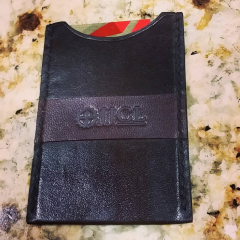-
Posts
121 -
Joined
-
Last visited
Content Type
Profiles
Forums
Events
Blogs
Gallery
Everything posted by OurJud
-
-
I've had a good search for this Weldwood cement and typically it's not available over here in the UK. Why is the UK so crap for leather goods?? Good point you make about the rarity of glued-only leather products... it does make you wonder. My mum has a sewing machine, but it's just a basic dress-making model. I've tried it on a few scraps of thin stuff (1.5mm) and I've found if I turn the wheel by hand rather than using the treadle it kind of works. Another idea I had was to make the holes with the machine (no thread) and then hand stitch.
-
Ooh, thanks camano! I find stitching far too time consuming and actually prefer the clean lines a sitichless leather product gives. I know saying such a thing on a leather forum is sacrilege, but there you go. I've had a look at the Barge cement I've seen mentioned, but it's a little pricey. Thanks again.
-
-
Simple question: Is there a glue/adhesive that bonds leather as securely or more securely than stitching? For clarity, I'm referring to the areas which are normally stitched, i.e the edges of wallets.
-
Okay, for the benefit of those who haven't given up on me... :D I thought it only right to tie up this thread and say I've finally decided how I'm going to do it. I was having a good mess around with cardboard templates/prototypes and came up with this: Diag 1: Two pieces of leather, cut to size as before. Then I take a length of elastic (long enough to wrap around the length of a credit card with a slight lap over where they meet again. I then lay and glue this elastic, centrally, on the flesh side of one piece of leather with some stretch glue, and run a stitch up either side, thus securing the elastic in place. Diag 2: I then take the other piece of leather and cut a slot from top to bottom at either end. Then feed the loose ends of the elastic around the edge and back through the slots on either end (so that the elastic is now on the inside again (indicated by the dashed line)). Glue the ends together. Done. Please note, I have the flesh side and skin side the wrong way round in diag 2.
-
I really am getting a headache now. Either I'm the stupidest person on God's earth or you're not understanding what it is I'm trying to do. Having said that, looking at gary's illustration again (post #17), I think it finally clicked. I can see how he's saying I need to do it, the only bit I don't understand is why he's suggesting I need to stitch it inside out in the first place. In that I want the elastic on the inside (as in the first two drawings) why can't I just do it like this but with the leather the right way round?
-
But how can I do the same with the other two edges, after I've stiched the first? The freedom of movement and accessibilty that allowed me to stitch the first edge in place will be lost once I've stitched it. I'm just not understanding the 'turn it inside out' part or why you think I will have easy access to the other three sides after I've stitched the first. I'm honestly starting to think I have serious mental and learning issues, as these instructions are obviously making perfect sense to everyone but me.
-
Thanks, Paul, I appreciate you going to such lengths to illustrate your method. Unfortunately (please don't hate me) I only half understand. Your illustration shows how to attach the elastic to one piece of leather, but what about the other piece? BDAZ, I'm getting slightly embarrassed by this thread now, and have to admit I still don't understand your suggestion. But look, this is my problem and you've all gone out of your way to try and help (sorry I haven't understood most of your ideas). I'll just say a big thanks to all of you, but I won't take up any more of your time with this now. Just gonna have to figure it out myself (using the answers already given as a guide ).
-
Not necessarily. Stephen, gary, Tree, thank you also. I think I can see what you're suggesting now, and gary your disagram makes your method much easier to understand.
-
That's a thought, just so long as the glue would hold up to being stretched that far.
-
I think I must have some form of blindness when it comes to following advice/instructions. Either that or people are not understanding (understandly so) what it is I want to do. Paulsleather, I can't get my head around what you mean. When you say that by giving up the lap seam I would have access on both sides to do the stitching, how do you mean? The whole point is to avoid stitching the leather pieces to each other, so that they can freely expand on the elastic as you add more cards. gary, I'm afraid I don't get any of what you say. How do I turn something inside out that needs to be attached on three sides?
-
Thanks for all the answers. Unfortunatley I don't have money to go buying miniture sewing machines (even if they do exist). electrathon, I think I'm following, but not entirely sure. Are you saying stitch it one piece (as the drawing) but then feed it through slots cut into the other piece and glue the ends together? It's an idea, but I wanted the elastic hidden between the two pieces of leather. I suppose I could come round the edge of the leather and then through the slots from the back, but then it would be difficult to get my hands in there to glue it. I think I might take up brain surgery. I'm sure it's far easier than this leather craft lark! I've slept, dreamt, talked, and eaten this damn wallet and I'm sick to the back teeth of it before I've even made it.
-
Sorry, Stephen, I was with you up to a point. I just don't see how your soloution would mean I didn;t have to stitch inside the confines of the wallet interior. Sturme, I understand a bit better now. I was forgetting that sttiching the elastic to the bottom of the other piece would be easy enough, but I still think stitching the way you suggest would be incredibly difficult. Maybe a bit ambitious when I think about it. Might have to go back to my stitchless design, but I keep hitting brick walls with even that.
-
But if I do that I won't have the expansion element because the elastic will be stitched together. Maybe I didn't explain properly. Imagine I'd managed to do what I wanted, I would be able to take one side of leather in one hand, and the other in my other hand, and pull them apart (as far as the elastic would allow).
-
I hope I can explain what it is I want to do here, because for the life of me I can't figure out how it might be acheived. Take two pieces of leather, slightly bigger than a credit card. I now want to attach these two pieces of leather together by bridging three sides (two sides and the bottom) with strips of elastic. Imagine you now have two pieces of leather attached only by these three strips of elastic, that allow the wallet to expand as you insert more and more credit cards. Look at the wallet as a concertina and you're almost there. Now, stitching the runs of elastic to each of the three edges on one piece of the leather isn't a problem, but how would I then do the same with the second piece of leather? Whether by machine or hand, how would I possibly get to the parts I need to stitch? Here's a crude sketch of one piece of leather with the elastic stitched in place. How on earth would I now stitch those exposed ends of elastic to the other piece of leather to form the card wallet?
-
Okie dokie! Thanks, chaps!
-
Well now that I know what I'm looking for I'm finiding all kinds of UK stockists that do similar stuff, sold by the metre. Thanks, Tree Reaper
-
Typical! This looked perfect until I saw the price. I could get a nice black trim, at exactly the size I want, but at $238.50, it's just a little too steep I must have done something wrong! We're talking 2mm wide trim here... how can it cost that much? Ah, seems it's only available fin 500 ft rolls. Wonder how much I'll get in a sample.
-
Channel? So that's what the long strips are called? I keep searching but don't know what words to use.
-
Crimp on corners are a thought. Thanks, Tree Reaper.
-
Don't know if such a thing exists - my searches certainly didn't unearth anything. I'm considering edging two, short ends of my leather wallet. It will be a simple piece of leather folded in half to accomodate bills (also folded in half) and up to 10 credit cards, but because folded bills are wider than credit cards, this results in about 1.5cm of 'unsupported' leather where the credit cards end, and it is these two ends I'd like to edge with little metal trims of some sort, rather than just having ugly ends exposed. I'm thinking something that you just feed over the leather ends and then crimp into place with pliers. Hope I've explained that clearly enough.
-
Thanks, cem.
-
Thanks, gary.
-
Thanks everyone - why are things that are worth doing never easy?? Can anyone answer me that? Gary, what do you use to push your sharpened needle through your leather, a thimble? Just to pick up on a few more points - sorry if I miss you: Chris, you ask a good question regarding punching the holes. Typically for me I hadn't thought that far ahead. gary, I didn't realise Tiger thread came as thin as 0.4mm. I bought some from Ian Atkinson's etsy store last week and opted for the smallest he was offering (0.8mm). I presumed this was as thin as TT came. Dwight, I like the idea of using a saw blade to mark my stitch holes. I shall investigate further.







